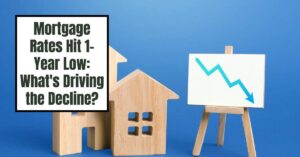This week offers a fresh outlook on mortgage rate predictions, particularly as we observe a notable shift in the housing market dynamics. As of today, August 12, 2024, the average interest rate for the benchmark 30-year fixed mortgage stands at 6.51%, down from previous weeks, signaling potential opportunities for homebuyers and those looking to refinance. But what does this mean for the coming days?
Mortgage Rate Predictions for the Week of Aug. 12-18, 2024
According to Bankrate, today’s average 30-year refinance interest rate is 6.52%, reflecting a decrease of 24 basis points from last week. Additionally, the 15-year fixed refinance rate has fallen to 5.94%, a reduction of 28 basis points from the previous week. This trend indicates that 2024 could be a year of easing mortgage rates, following a period of higher figures.
What's Driving the Changes?
The decline in mortgage rates can be attributed to several key factors:
- Federal Reserve Decisions: In its July meeting, the Federal Reserve refrained from altering interest rates, signaling potential cuts in September. This led to positive market reactions, contributing to lower mortgage rates.
- Economic Indicators: A recent disappointing job report has intensified concerns about a recession. Such economic data typically drives down longer-term bond yields, particularly that of the 10-year Treasury, which indirectly influences mortgage rates.
- Market Responses: Following the labor report, the market saw a significant drop in Treasury yields, prompting a corresponding decrease in mortgage rates.
What to Expect This Week
As we move through the week of August 12-18, 2024, here are some possibilities based on current trends:
- Stable or Slightly Increasing Rates: While the recent trend has been a decrease, financial markets generally stabilize following significant changes, which could cause a slight rise in mortgage rates in the short term.
- Impact of Inflation Data: Upcoming inflation figures due on August 14, 2024, could either reinforce the downward trend in mortgage rates or introduce volatility, depending on how they reflect price movements.
- Variations for Homebuyers: Prospective homebuyers and current homeowners considering refinancing should stay vigilant about daily fluctuations. Although the average rates dipped recently, an uptick could occur, so keeping a watchful eye on the market is advisable.
Long-Term Outlook
Looking ahead, most economists and mortgage experts concur that while mortgage rates have fallen, a more realistic expectation for the average rate throughout the remainder of 2024 would be around 6%. Notable players in housing and economic forecasting, such as Fannie Mae and Freddie Mac, are adjusting their predictions as the year progresses.
The Fed will hold three additional policy meetings this year on September 17-18, November 6-7, and December 17-18. As the election approaches, significant changes to interest rates may be less likely post-September, especially if economic conditions do not warrant drastic measures.
Risks and Considerations for Homebuyers
While the declining trend in mortgage rates might be appealing, potential homebuyers should consider:
- Employment Conditions: Economic recovery may hinge on job growth and stability. Fluctuations in employment could influence Fed actions.
- Inflation Tracking: Ongoing inflation will be a critical factor in determining the stability of lower mortgage rates. Should inflation rise again, it may lead the Fed to reconsider its approach.
- Anticipating Future Mortgage Needs: Buyers should plan their financing options while remaining cognizant of changes in the economic landscape. The expected easing of rates could provide a window of opportunity but requires timely decision-making.
Conclusion
As we navigate the week of August 12-18, 2024, there are clear signs that mortgage rates are trending downwards, creating favorable conditions for both first-time buyers and those seeking to refinance. The impact of recent economic indicators and Fed policies will play a crucial role in shaping mortgage trends in the immediate future.
For anyone looking to enter the housing market or refinance, this week offers a pivotal moment. Engaging with financial advisors and following updates will provide the insights necessary for making informed decisions.
ALSO READ:
- How to Lower Your Mortgage Payment Without Refinancing?
- How Lower Mortgage Rates Can Save You Thousands?
- How to Get a Low Mortgage Interest Rate?
- Will Mortgage Rates Ever Be 4% Again?
- Will Mortgage Rates Ever Be 3% Again: Future Outlook
- Mortgage Rates Predictions for Next 2 Years
- Mortgage Rate Predictions for Next 5 Years
- Mortgage Rate Predictions for 2025: Expert Forecast
- Mortgage Rate Predictions: Why 2% and 3% Rates are Out of Reach










